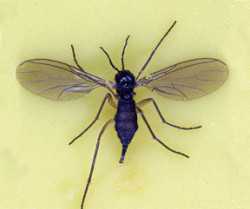Pest Of The Month: Darkwinged Fungus Gnats

Identification
The larvae are white, slender, legless maggots which grow to 1/4 inch. They have a black head and smooth semi-transparent skin revealing digestive tract contents. There is nothing else similar in the greenhouse.
The adults are small, delicate flies with a dark-brown body, dusky wings, and a small head with rounded, prominent eyes that meet above the bases of the antennae. Fungus gnat adults are about 1/8-inch long flies with long spindly legs and long, thread-like antennae. They resemble tiny mosquitoes more closely than common flies.
When disturbed, fungus gnats run rapidly or take flight, which usually consists of short darting or hovering movements over a small area. In addition, large numbers of flying gnats may be a nuisance to workers.
The adults are small, delicate flies with a dark-brown body, dusky wings, and a small head with rounded, prominent eyes that meet above the bases of the antennae. Fungus gnat adults are about 1/8-inch long flies with long spindly legs and long, thread-like antennae. They resemble tiny mosquitoes more closely than common flies.
When disturbed, fungus gnats run rapidly or take flight, which usually consists of short darting or hovering movements over a small area. In addition, large numbers of flying gnats may be a nuisance to workers.
Survival And Spread
Bradysia is represented by 65 species in North America. It also is found on all other continents. Examples of Bradysia have been collected from all regions in Florida, but very few have been determined to species. Studies suggest fungi provide an essential nutrient source for the larvae and that if fungi are in low supply in the immediate vicinity of a living plant, the larvae will use the plant as an alternate food source.
Under lab conditions at 75°F, the average female will lay 75 eggs, and average length of life cycle about 27 days, but this varies with temperature fluctuations and environmental conditions. Most of the larvae occur in the top inch of soil and require moist to very moist soil or substrate for development.
Under lab conditions at 75°F, the average female will lay 75 eggs, and average length of life cycle about 27 days, but this varies with temperature fluctuations and environmental conditions. Most of the larvae occur in the top inch of soil and require moist to very moist soil or substrate for development.
Management Methods
Sound management practices can help remove the conditions necessary for the development of fungus gnats and reduce the need for pesticides and promotes parasites.
Fungus gnat problems are exacerbated by over-wet conditions and diseased roots and are a symptom of poor cultural practices. Potting media should be stored dry, and pots and production areas must be well drained. Fungus gnats can exist on soil fungi, algae under benches, and on damp mossy benches. Some growers apply hydrated lime to eliminate the fungal food source. An integrated pest management approach that includes good water management, practices that promote good root health, and judicious use of insecticides will keep most fungus gnat problems under control.
Some growers report difficulty achieving adequate control of fungus gnats, and more information is needed on effective insecticides, dosage rates, methods of application, and possible phytotoxicity.
Fungus gnat problems are exacerbated by over-wet conditions and diseased roots and are a symptom of poor cultural practices. Potting media should be stored dry, and pots and production areas must be well drained. Fungus gnats can exist on soil fungi, algae under benches, and on damp mossy benches. Some growers apply hydrated lime to eliminate the fungal food source. An integrated pest management approach that includes good water management, practices that promote good root health, and judicious use of insecticides will keep most fungus gnat problems under control.
Some growers report difficulty achieving adequate control of fungus gnats, and more information is needed on effective insecticides, dosage rates, methods of application, and possible phytotoxicity.
0
1
5
Pest Of The Month: Darkwinged Fungus Gnats










